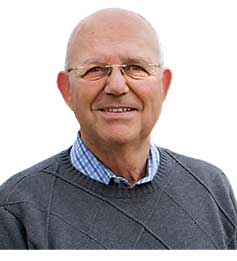A new chapter

Mike Kenna
First of all, I’m excited to have a Golfdom column. I thought an introduction about how I arrived at this point in my career would be a good start.
I grew up in El Cajon, Calif., and at the age of 15 worked at Singing Hills Country Club. Dave Fleming was the superintendent, and he had a significant influence on my career.
In 1974, after high school, I attended the University of California-San Diego, majoring in biology. I planned to go to medical school after completing my B.S. degree. With a 3.2 GPA, it didn’t look promising to get into medical school.
Dave Fleming suggested I attend Cal Poly-Pomona to become a golf course superintendent.
Kent Kurtz, Ph.D., was my adviser at Cal Poly, and he asked me to be a student assistant, setting up turfgrass labs and working at the turfgrass research plots. This part-time job was the beginning of my interest in research.
My senior project was on zoysiagrass iron chlorosis. I worked with experimental lines from Vic Younger, Ph.D., at the University of California, Riverside (UCR). Seeing differences among the lines at different soil pH sparked my interest in plant breeding.
I loved to conduct research, and Kent arranged graduate school at Oklahoma State University (OK State). Wayne Huffine, Ph.D., advised me on my master’s degree, but I spent hours visiting with Charles Taliaferro, Ph.D. My dream was to develop better warm-season grasses for golf.
Five years of study at OK State resulted in an M.S. degree in agronomy and a Ph.D. in crop science. I specialized in plant breeding, physiology and statistics. Unfortunately, there were no warm-season turfgrass breeding jobs in the spring of 1984.
It was around then that USGA started the Green Section’s Turfgrass Research Program. Professor Younger at UCR received a zoysiagrass breeding grant from USGA. It would be great to get back to California and work for him as a postdoc. It was not to be. Professor Younger suffered a major heart attack, and we lost a brilliant turfgrass scientist.
I still went to UCR in the summer of 1984 to visit with Vic Gibeault, Ph.D., about a possible turfgrass job. He told me the USGA moved the project to the Texas A&M University research station in Dallas. He gave me the phone number of Milt Engelke, Ph.D., and after a short phone call, I was driving to Dallas to meet him.
Professor Engelke and Jack Murry, U.S. Department of Agriculture, had collected more than 800 zoysiagrasses from throughout Asia. The USGA grant was for $20,000 per year. So, my first job after graduate school was a postdoc position with a salary less than the grant amount. Yet, what an opportunity to get more turfgrass breeding experience.
Eighteen months later, the turfgrass Extension job opened at OK State. In November 1985, I was on my way to OK State with a university position. Even better, in 1986, professor Taliaferro received a USGA grant to develop cold-tolerant bermudagrasses.
The time with Engelke and Taliaferro helped me meet the USGA Green Section’s national director, Bill Bengeyfield. I served as a volunteer on the research committee from fall 1987 to December 1989.
In January 1990, I applied for a USGA Green Section position in Florida with John Foy. A few weeks after hiring me for the job, Bill Bengeyfield retired. Shortly afterward, Jim Snow, the new national director, asked me to be the director of research for the Green Section.
From the day Jim called me, my 30 years with USGA were terrific. In future columns, I will share with you some great stories about the scientists who have crossed my path. More important, I’ll tell how these dedicated turfgrass scientists have changed golf forever.
Seth Jones and Golfdom, thank you for the opportunity. Stay tuned; I have stories to tell.










